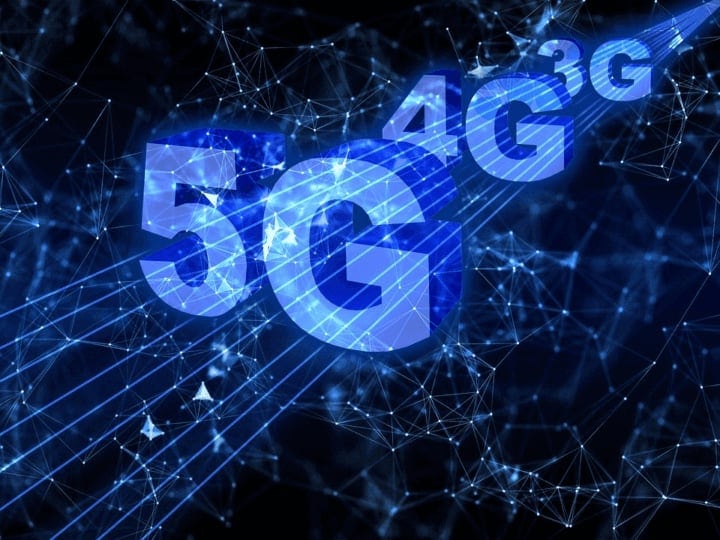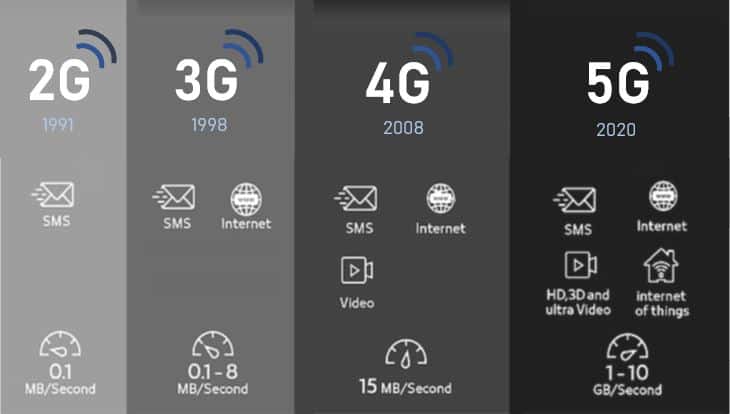5G vs 4G: Why is 5G better?

5G is the latest generation in mobile communications technology. 5G promises to provide increased speed, faster streaming and less buffering in comparison to 4G. With 5G around the corner, many businesses still haven’t yet grasped the opportunities that 5G can offer. 5G promises significant advantages vs 4G. To understand the opportunities offered by 5G, it is essential to understand how 5G compares to 4G, and what benefits these differences bring for business.
On this page:
From 4G to 5G: A revolutionary evolution?
The early 2000s saw the launch of 3G and the introduction of internet access from mobile phones. Building on this technology, 4G and 4G LTE, ushered in an era mobile internet, browsing capabilities and mobile apps.
Thanks to this development in mobile technology, accessing the internet, using mobile applications for online banking, reading the news, ebook and email, and streaming music and video on our mobile devices has become a part of our everyday lives.
Similarly building on previous technologies such as 4G and 4G LTE, 5G is the next link on the evolutionary mobile tech chain, promising to provide higher-quality speed and improved reliability than previous 4G technology.

However, where 5G becomes revolutionary, is when you take into consideration parallel developments in the technology sector, particularly in the fields of Artificial Intelligence (AI), and Internet of Things (IoT). The higher speeds, lower latency, and increased bandwidth and reliability offered by 5G will enable the practical application of these technologies to a wide range of prospective areas.
See also: What opportunities does 5G present for small businesses?
Why is 5G better than 4G?
We’ve all heard the sales pitch for 5G – faster, better, more efficient. But what makes 5G better than 4G?
In part, it comes down to the higher frequency in which 5G operates versus 4G. 5G operates on three frequency bands, low, medium, and high. While both 4G operates in the 600-700 MHz range, giving 30-250 megabits per second (Mbit/s), 5G will function in the 600MHz to 25-39 GHz range. At the higher end, 5G is capable of achieving download speeds of a gigabit per second (Gbit/s), similar to broadband internet.
The shift to 5G is akin to the shift from the horse and cart to cars. 5G will provide a platform for other technologies such as Internet of Thing (IoT), and underpin the future of the digital economy, enabling economies to generate trillions of pounds of value.

5G vs 4G: Speed – How much faster is 5G compared to 4G?
Speed is one of the defining characteristics of 5G in comparison to 4G.
The significant increase in speeds offered by 5G will potentially alter the manner in which we use our mobile devices. The higher frequency that 5G operates in provides higher speeds, which means more bandwidth, which in turn will enable the transfer of large volumes of data.
Compared to 4G, 5G will be up to 20 times faster and support billions of digital devices with much-increased reliability and security.
While 4G LTE has a speed of 1Gb/s, 5G will be able to achieve 20Gb/s.
Of course, these speeds are theoretical, and the actual performance offered by 5G will be evident once 5G is rolled out. But to provide some context, at least theoretically, you could download a one-hour film on 5G, it is completed in less than 40 seconds. Compared to 4G, where the film may take 2-3 minutes ot download, the speeds offered by 5G become appraent. In the example provided, 5G reduces download times by up to 10%.
5G vs 4G: How does 5G reduce latency?
Latency is the time taken to send data and receive a reply. High latency is often described as “lag” and can often cause problems for rapid communications. With 5G, latency is significantly improved in comparison to 4G.
5G achieves lower latency thanks to significant advances in mobile device technology and mobile network architecture. 4G has a latency of approximately 50 milliseconds, while 5G offers latency as low as one millisecond.
| Technology | Response time in
milliseconds (ms) |
| 4G – LTE | 20-50ms |
| 5G – Enhanced mobile broadband | 4-5ms |
| 5G – Ultra-Reliable Low Latency Communications (URLLC) | 1ms |
For 5G, the issue of latency is tackled in several different ways. It primarily involves significant changes to the 5G network mobile network architecture to deliver lower latency:
- Core Network – The core manages all of the mobile voice, data and internet connections. In a 4G world, data has to travel farther to reach you. That adds extra milliseconds – and therefore, extra latency. With 5G, data doesn’t have to travel nearly as far. By integrating more cloud computing technologies directly into the 5G towers, any data request is responded to at the tower. By moving the content closer to the end-user, the path between devices is shortened, thereby lowering latency.
- Radio Access Network (RAN) – These are the small cells, towers, masts and dedicated in-building and home systems which provide the connectivity between mobile users and the main core network. Implementing a dynamic and configurable Radio Access Network will allow the network to operate at very low latency and high throughput. In part, this is achieved by network slicing, cutting the overall network bandwidth into smaller segments, at both the core and RAN. Network slicing will ensure that certain segments have less traffic than others, thereby reducing latency.
Why is latency significant? Well, 5G will potentially reduce latency down to 1ms. This opens up a wealth of opportunities for new technologies and the application of those technologies.
For context, 1ms is 1/one thousandth of a second or 0.001 sec. Latency this low will allow almost instantaneous data transfer. Essentially, such low latency will drive the application of technology where tactile and responsive feedback is critical, such as AI and robotics, remote healthcare, autonomous vehicles, and virtual reality (AR) and augmented reality (VR).

5G vs 4G: Capacity
Radio waves are used by all mobile networks to transfer data, but when it comes to 5G vs 4G, 5G will use the higher end of the spectrum for data transfer. 5G will operate in the high-frequency range, between 30 and 300GHz, whereas 4G performs at sub-6GHz frequencies.
Higher frequencies allow for larger bandwidths to be employed. The larger the bandwidth, the more capacity is available for data transfer, such as apps, streaming or downloading, and the less data traffic than at the lower frequencies.
Using technologies like Massive MIMO, 5G will use this spectrum more intelligently – ensuirng users can get the capacity they need when needed.
The capacity potential of 5G will open the door for new business models in everything from field service and logistics to facilities management, commercial real estate and emergency services. Field service engineers use it to get step-by-step instructions. Architects use it to ‘walk’ clients through a not-yet-built school. And consumers use it for multi-player games and immersive movies.
5G Business opportunities
One of the key advantages of 5G is that the higher frequencies can be used in parallel to other wireless signals without causing any interference. Since it isn’t affected by the signals around it, 5G is suited to work well in high-density areas which have high levels of traffic. As 5G offers increased data accessibility and increased speed, it is anticipated that 5G will drive technology innovation in several areas:
- Autonomous vehicles: 5G provides a uniform, always-on connection which autonomous vehicles will require. 5G will enable V2V (vehicle to vehicle) and V2X (vehicle to infrastructure) communication to relay crucial information to other road users. 5G will let these vehicles transmit data among themselves and with IoT enabled infrastructure on the road. The “smart” infrastructure will improve public and road safety, alert drivers of any obstructions, and facilitate rapid emergency response in case of accidents.
- Emergency services – 5G’s low latency will allow for more remote control devices which require responsive and tactile feedback. For example, the use of robots in reducing risk to personnel in hazardous environments will enable technicians with specialised skills to operate machinery from anywhere in the world. Due to its low latency, 5G will provide a vast network with almost instantaneous response times to enable fast response to accidents and emergencies in seconds, instead of a few minutes.
- Healthcare: Health providers can use different communications and sensor networks networks to track patients accurately and therefore share data between them faster.
- Logistics and transportation: There is better communication in travelling and sending goods and services all over the world, including the operation of delivery drone/robot services.
- Public safety and civil infrastructure: Local and civic authorities will be able to improve local infrastructure by providing, for instance, streetlight monitoring and control, drain/flood data, localised vehicle traffic management.
See also What is Internet of Things (IoT)? and discover how 5G enables IoT to deliver benefits to businesses.
5G does not mean 4G is obsolete
Many people still use 3G when they have no access to 4G, and it will be the same for 5G. If you feel that 5G is going to replace 4G, it is not. It is just advanced technology. When the two of them work hand in hand, we can get excellent internet speed no matter where we are.
It is also essential to know that will keep upgrading 4G networks, so the downloading speeds and proper latency will improve more and more. Proper 5G networks have begun to be implemented in many big cities, but even if you live in a big city, only certain areas of the city have 5G.
There are only a few types of phones that have 5G, and a lot of phones and city areas still need a year or two before able to get 5G services.
5G Availability
So, when will the 5G be available? Is it possible to access the network on the current devices that you have?
The first service provider to produce the 5G is Vodafone. The next two service providers that are launching 5G are EE and O2.
In the start, 5G will come out in big UK cities like London and Birmingham. These cities will enjoy 5G first, with the other cities to come. Rural areas already have 4G, so people staying there might not get news or be interested in 5G when it first launches.

